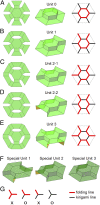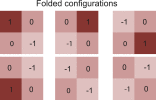Algorithmic lattice kirigami: A route to pluripotent materials
- PMID: 26015582
- PMCID: PMC4475981
- DOI: 10.1073/pnas.1506048112
Algorithmic lattice kirigami: A route to pluripotent materials
Abstract
We use a regular arrangement of kirigami elements to demonstrate an inverse design paradigm for folding a flat surface into complex target configurations. We first present a scheme using arrays of disclination defect pairs on the dual to the honeycomb lattice; by arranging these defect pairs properly with respect to each other and choosing an appropriate fold pattern a target stepped surface can be designed. We then present a more general method that specifies a fixed lattice of kirigami cuts to be performed on a flat sheet. This single pluripotent lattice of cuts permits a wide variety of target surfaces to be programmed into the sheet by varying the folding directions.
Keywords: origami; pluripotent; topological defects.
Conflict of interest statement
The authors declare no conflict of interest.
Figures










References
-
- Hamm CE, et al. Architecture and material properties of diatom shells provide effective mechanical protection. Nature. 2003;421(6925):841–843. - PubMed
-
- Klein Y, Efrati E, Sharon E. Shaping of elastic sheets by prescription of non-Euclidean metrics. Science. 2007;315(5815):1116–1120. - PubMed
-
- Miura K. 1980. Method of packaging and deployment of large membranes in space. Proceedings of the 31st Congress of the International Astronautical Federation, IAF-80-A 31 (Am Inst Aeronaut Astronaut, New York), pp 1–10.
-
- Mahadevan L, Rica S. Self-organized origami. Science. 2005;307(5716):1740. - PubMed
Publication types
LinkOut - more resources
Full Text Sources
Other Literature Sources

